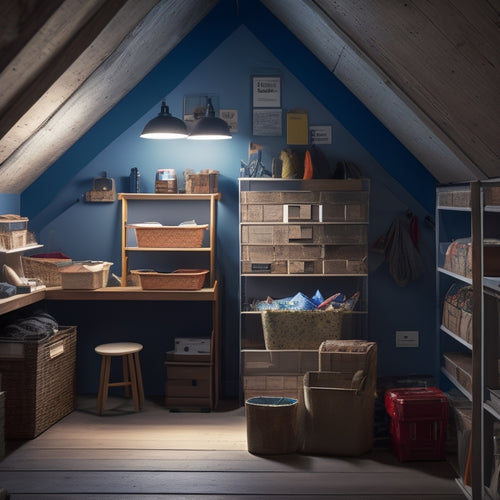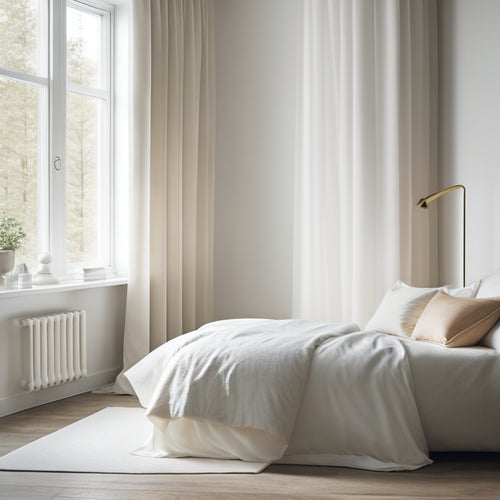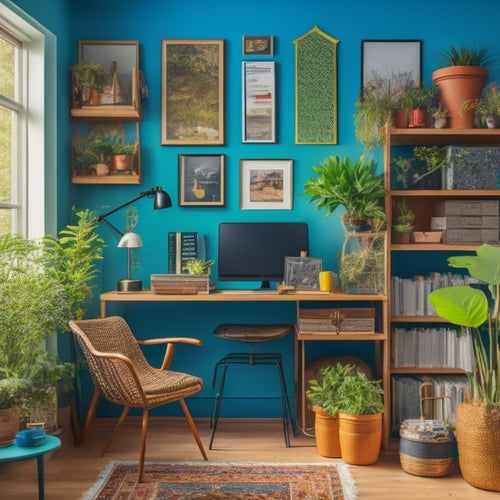
Dining Room Decluttering and Storage Solutions
Share
You're taking the first step towards transforming your dining room into a clutter-free oasis by tackling the challenging tasks of decluttering and strategic storage. Start by removing everything from the room, categorizing items, and evaluating what you truly need. Consider the style and ambiance you want to achieve, and think about table setting ideas to determine which decorative accents to keep. From hidden compartments to creative shelving and storage ottomans, you'll discover innovative solutions to maximize your space. Now, get ready to uncover more ideas and inspiration to turn your dining room into a beautifully organized haven.
Key Takeaways
• Remove everything from the dining room, categorize items, and assess what is truly needed to declutter and organize the space effectively.
• Utilize vertical storage options like floor-to-ceiling shelves or bookcases to maximize storage space in small dining rooms.
• Consider incorporating hidden compartments, creative shelving, and decorative storage ottomans or benches for stylish and functional storage.
• Optimize table placement for conversation, movement, and meal prep to create a functional and aesthetically pleasing dining space.
• Implement customizable storage options like adjustable shelves, baskets, and bins to adapt to evolving needs and keep the dining room organized.
Dining Room Decluttering Essentials
Before you can create a functional and beautiful dining room, you need to purge it of clutter, and that process begins with a few essential tools and a clear understanding of what's holding you back from achieving your desired space.
You'll need a trash bag, a donation box, and a label maker to get started. Take everything out of your dining room, including decorative accents and table settings, and sort items into categories. Be honest with yourself about what you truly need or use regularly. Consider the style and atmosphere you want to create in your dining room and let that guide your decisions.
As you declutter, think about the table setting ideas you want to incorporate. Do you want a formal, elegant look or a casual, cozy feel? This will help you decide what decorative accents to keep and what to let go of.
Storage Solutions for Small Spaces
Now that your dining room is decluttered, you're likely left with a few essential items that need a designated spot, and finding storage solutions for small spaces can be a challenge, especially when you need to prioritize functionality without sacrificing style.
One effective way to maximize storage in small spaces is to incorporate hidden compartments and creative shelving. Consider installing shelves with built-in drawers or cabinets to store items like fine china, linens, or candles.
You can also use decorative storage ottomans or benches with hidden compartments to stash away items like placemats, napkin rings, or table runners.
Another smart approach is to utilize vertical storage to keep your dining room organized and clutter-free. Install floor-to-ceiling shelves or bookcases to store infrequently used items, such as special occasion dishes or cookbooks.
Additionally, consider using under-table bins or pedestal storage to keep items like tablecloths, placemats, or centerpieces within easy reach.
Organizing Dining Room Furniture
You've successfully tackled storage solutions for your small dining room, and now it's time to turn your attention to the furniture itself, arranging it in a way that creates a functional and inviting space.
Start by considering the furniture arrangement. Think about the flow of traffic and how you want people to move through the room. Create a focal point, like a statement piece of furniture or a stunning view, and arrange the rest of the furniture around it. Don't forget to balance the room with decor accents like vases, artwork, or plants.
Next, think about lighting options. Consider layering different light sources, such as overhead lighting, table lamps, and floor lamps, to create a warm and inviting atmosphere.
Choose a color scheme that complements your furniture and decor accents. A cohesive color scheme can tie the room together and create a sense of harmony. Remember, the key is to create a space that's both functional and aesthetically pleasing.
Creating a Functional Layout
Now that you've organized your dining room furniture, it's time to create a functional layout that makes mealtime a breeze.
You'll want to focus on three key areas: optimizing table placement, streamlining seating options, and defining traffic paths.
Optimize Table Placement
By strategically positioning your dining table, you can create a functional layout that facilitates conversation, movement, and meal prep. Consider the room's traffic flow and place the table in a way that allows easy access to the kitchen and other areas of the room. This will create a smooth progression between meal prep and dining.
When deciding on a table centerpiece, choose something that's visually appealing but doesn't obstruct conversation. A simple vase or a decorative candle can add ambiance without taking up too much space.
Seating arrangements should also be considered, ensuring that each guest has enough elbow room and can easily get in and out of their seat.
Don't forget to think about lighting fixtures and wall decor when optimizing your table placement. A well-placed chandelier or pendant light can add warmth and ambiance to the space, while wall decor such as artwork or mirrors can create the illusion of a larger room.
Streamline Seating Options
Your dining room seating arrangement plays an essential role in creating a functional layout, as it directly impacts the flow of conversation and movement around the table.
When choosing seating options, consider the number of people you'll be seating regularly. Folding chairs can be a great space-saving solution for occasional guests, while bench seating can provide a cozy, intimate atmosphere for everyday meals.
If you're looking for a more modern take, consider incorporating cushioned stools or modular benches into your design. These options can provide additional storage and flexibility, while also adding a touch of style to your dining room.
When selecting seating, think about the comfort and ergonomics of your guests. Will they be sitting for extended periods, or just for quick meals? Do they need back support or armrests? By considering these factors, you can create a seating arrangement that's both functional and inviting.
Define Traffic Paths
You've optimized your seating arrangement, but now it's time to think about the flow of traffic in your dining area, as a clear path around the table and to surrounding areas will make mealtime more efficient and enjoyable.
To define traffic paths, consider the furniture arrangement and space planning in your dining space. Think about how you and your guests will move around the table, to the kitchen, and to other adjacent areas.
A well-planned room flow is essential to a functional dining space. You want to make sure that there's enough space to comfortably move around the table and chairs without feeling cramped or claustrophobic.
Consider the design elements in your room, such as the location of doors, windows, and any built-in shelves or cabinets. These elements can impact the flow of traffic and influence your furniture arrangement.
DIY Shelves and Cabinets Ideas
Now that you've optimized your dining room's layout, it's time to focus on maximizing storage and display space with DIY shelves and cabinets.
You'll want to contemplate space-saving shelf designs that fit your room's unique dimensions, clever cabinet organization hacks to keep essentials within reach, and customizable storage options that adapt to your evolving needs.
Space-Saving Shelf Designs
Built-in shelves and cabinets can be a game-changer for maximizing vertical storage in your dining room, especially when designed with space-saving features like slide-out drawers and adjustable compartments. By incorporating these features, you can efficiently store and display your dining essentials while keeping the floor clear.
Consider installing floating shelves with hidden compartments to stash away less frequently used items, such as special occasion dishes or linens. This design not only saves space but also adds a touch of sophistication to your dining room.
For a more minimalist approach, opt for vertical storage units with sleek, streamlined designs. These can be customized to fit your specific needs, providing ample storage for everything from dinner plates to cookbooks. By going vertical, you'll make the most of your dining room's ceiling height, creating a sense of openness and airiness.
With these space-saving shelf designs, you'll be able to enjoy a clutter-free dining space that's both functional and stylish. By implementing these ideas, you'll be well on your way to creating a dining room that's perfect for relaxing and entertaining.
Cabinet Organization Hacks
By repurposing existing cabinets or creating your own DIY shelves, you can turn cluttered storage spaces into organized havens that keep your dining room essentials within easy reach. This is especially important for kitchen cabinets, which can quickly become overwhelmed with dishes, cookware, and food storage containers.
By implementing a few cabinet organization hacks, you can maximize your storage space and reduce clutter.
Here are some ideas to get you started:
-
Install adjustable shelves: This allows you to customize your shelf heights to fit different-sized items, making the most of your vertical storage space.
-
Use baskets and bins: Labelled containers can help keep similar items together and make them easy to find.
-
Add a pegboard: Hang frequently-used items like utensils, pots, and pans on a pegboard to free up shelf space.
- Implement pantry organization: Designate a specific area for food storage and use baskets, bins, or shelves to keep items organized and visible.
Customizable Storage Options
You can take your cabinet organization to the next level by designing and constructing customized storage options that fit your dining room's distinct needs and style. With DIY shelves and cabinets, you can create a personalized space that maximizes storage and minimizes clutter.
One of the benefits of customized storage options is that you can tailor them to your specific needs. For instance, you can design shelves with adjustable compartments to accommodate items of varying sizes. This flexibility guarantees that you can store everything from fine china to cookbooks in a way that makes sense for your lifestyle.
Here are some ideas to get you started:
| Customizable Feature | Advantages |
|---|---|
| Personalized shelving | Fits unique item sizes and shapes |
| Adjustable compartments | Accommodates items of various sizes |
| Built-in drawers | Provides concealed storage for linens and utensils |
| Sliding shelves | Allows for easy access to hard-to-reach items |
| Custom cabinetry | Maximizes storage in small or irregular spaces |
Maximizing Corner Storage Space
Corner spaces in your dining room often remain underutilized, but with the right strategies, they can become valuable repositories for storing items that would otherwise clutter your tables and shelves. By maximizing corner storage space, you can keep your dining room organized and create a more inviting atmosphere.
Here are some ways to make the most of your corner space:
-
Install a corner cabinet: A corner cabinet is a great way to store items like fine china, linens, or serving dishes. You can choose from a variety of styles and materials to match your dining room's décor.
-
Use wall shelves: Wall shelves can be installed in corners to store books, decorative items, or plants. They're perfect for adding visual interest and keeping items within easy reach.
-
Opt for a carousel: A carousel is a rotating storage unit that can be placed in a corner. It's ideal for storing items like wine bottles, glasses, or utensils.
- Incorporate a corner desk: If you have a small dining room, consider incorporating a corner desk that can serve as a homework station or a place to plan meals.
Frequently Asked Questions
How Do I Decide What Dining Room Items to Keep and What to Discard?
"You're not alone in feeling overwhelmed; 80% of Americans experience clutter anxiety! When decluttering, ask yourself: 'Do I use it regularly?' or 'Does it bring me joy?' If not, consider discarding or storing dining room items, making space for what truly matters."
Can I Use a Dining Room for Dual Purposes, Like a Home Office?
You can definitely use your dining room for dual purposes, like a home office, by incorporating space-saving solutions that maximize functionality, and designing the space for both productivity and comfort, allowing you to work efficiently.
How Often Should I Clean and Maintain My Dining Room Storage?
You should clean and maintain your storage regularly, aiming for a weekly tidy and a deeper clean every 2-3 months, to keep your space organized and make sure everything stays in its designated place.
Are There Any Specific Decluttering Strategies for Small Dining Rooms?
When tackling small spaces, you'll benefit from creative organization strategies, like vertical storage and multi-functional furniture, to maximize space saving solutions and make the most of your compact dining area's potential.
Can I Repurpose Old or Antique Furniture for Dining Room Storage?
You can breathe new life into old or antique furniture by refinishing or upcycling it for creative storage solutions, such as turning an old sideboard into a storage bench or using antique crates as shelves.
Related Posts
-

Unlock Attic Storage Potential With Online Guides
You're sitting on a treasure trove of storage space, right above your head! Reveal your attic's hidden potential by a...
-

Why Cluttered Bedrooms Are a Thing of the Past
You've finally said goodbye to cluttered bedrooms, thanks to innovative storage solutions that have revolutionized th...
-

3 Best Online Courses for Home Organization Skills
You're just a few clicks away from a clutter-free home and a more efficient daily routine. Three online courses can h...


